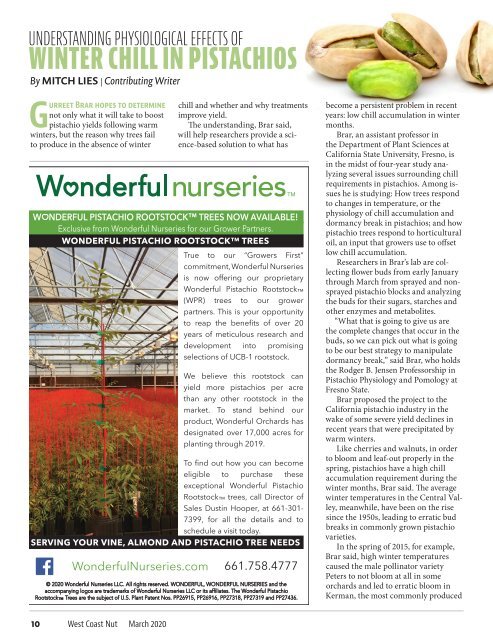WCN March 2020
You also want an ePaper? Increase the reach of your titles
YUMPU automatically turns print PDFs into web optimized ePapers that Google loves.
UNDERSTANDING PHYSIOLOGICAL EFFECTS OF<br />
WINTER CHILL IN PISTACHIOS<br />
By MITCH LIES | Contributing Writer<br />
Gurreet Brar hopes to determine<br />
not only what it will take to boost<br />
pistachio yields following warm<br />
winters, but the reason why trees fail<br />
to produce in the absence of winter<br />
W<br />
chill and whether and why treatments<br />
improve yield.<br />
The understanding, Brar said,<br />
will help researchers provide a science-based<br />
solution to what has<br />
NDERFUL PISTACHIO ROOTSTOCK TREES NOW AVAILABLE!<br />
Exclusive from Wonderful Nurseries for our Grower Partners.<br />
WONDERFUL PISTACHIO ROOTSTOCK TREES<br />
True to our “Growers First”<br />
commitment, Wonderful Nurseries<br />
is now offering our proprietary<br />
Wonderful Pistachio Rootstock <br />
(WPR) trees to our grower<br />
partners. This is your opportunity<br />
to reap the benefits of over 20<br />
years of meticulous research and<br />
development into promising<br />
selections of UCB-1 rootstock.<br />
We believe this rootstock can<br />
yield more pistachios per acre<br />
than any other rootstock in the<br />
market. To stand behind our<br />
product, Wonderful Orchards has<br />
designated over 17,000 acres for<br />
planting through 2019.<br />
To find out how you can become<br />
eligible to purchase these<br />
exceptional Wonderful Pistachio<br />
Rootstock trees, call Director of<br />
Sales Dustin Hooper, at 661-301-<br />
7399, for all the details and to<br />
schedule a visit today.<br />
SERVING YOUR VINE, ALMOND AND PISTACHIO TREE NEEDS<br />
WonderfulNurseries.com 661.758.4777<br />
© <strong>2020</strong> Wonderful Nurseries LLC. All rights reserved. WONDERFUL, WONDERFUL NURSERIES and the<br />
accompanying logos are trademarks of Wonderful Nurseries LLC or its affiliates. The Wonderful Pistachio<br />
Rootstock Trees are the subject of U.S. Plant Patent Nos. PP26915, PP26916, PP27318, PP27319 and PP27436.<br />
become a persistent problem in recent<br />
years: low chill accumulation in winter<br />
months.<br />
Brar, an assistant professor in<br />
the Department of Plant Sciences at<br />
California State University, Fresno, is<br />
in the midst of four-year study analyzing<br />
several issues surrounding chill<br />
requirements in pistachios. Among issues<br />
he is studying: How trees respond<br />
to changes in temperature, or the<br />
physiology of chill accumulation and<br />
dormancy break in pistachios; and how<br />
pistachio trees respond to horticultural<br />
oil, an input that growers use to offset<br />
low chill accumulation.<br />
Researchers in Brar’s lab are collecting<br />
flower buds from early January<br />
through <strong>March</strong> from sprayed and nonsprayed<br />
pistachio blocks and analyzing<br />
the buds for their sugars, starches and<br />
other enzymes and metabolites.<br />
“What that is going to give us are<br />
the complete changes that occur in the<br />
buds, so we can pick out what is going<br />
to be our best strategy to manipulate<br />
dormancy break,” said Brar, who holds<br />
the Rodger B. Jensen Professorship in<br />
Pistachio Physiology and Pomology at<br />
Fresno State.<br />
Brar proposed the project to the<br />
California pistachio industry in the<br />
wake of some severe yield declines in<br />
recent years that were precipitated by<br />
warm winters.<br />
Like cherries and walnuts, in order<br />
to bloom and leaf-out properly in the<br />
spring, pistachios have a high chill<br />
accumulation requirement during the<br />
winter months, Brar said. The average<br />
winter temperatures in the Central Valley,<br />
meanwhile, have been on the rise<br />
since the 1950s, leading to erratic bud<br />
breaks in commonly grown pistachio<br />
varieties.<br />
In the spring of 2015, for example,<br />
Brar said, high winter temperatures<br />
caused the male pollinator variety<br />
Peters to not bloom at all in some<br />
orchards and led to erratic bloom in<br />
Kerman, the most commonly produced<br />
10 West Coast Nut <strong>March</strong> <strong>2020</strong>


















